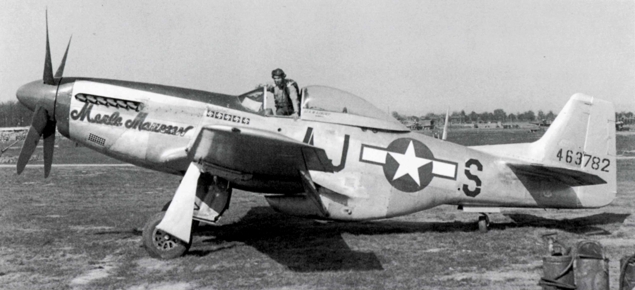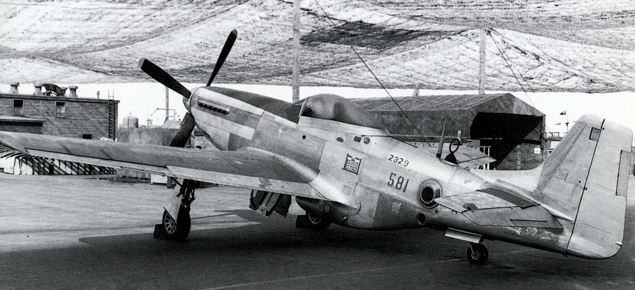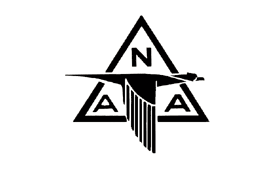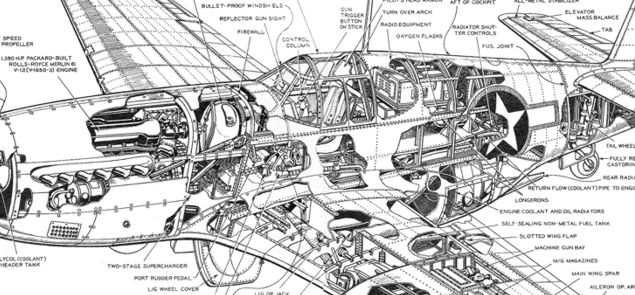History and Development
For those who flew it, the North American P-51 Mustang was a fighter pilot's airplane. To others, the name brings to mind one of the best fighter planes of World War II. Unlike other well-known and widely used fighters of that time, the P-51 was the first conceived during the war and built on the basis of combat experience.
The plane got its start because of the Royal Air Force’s shortage of airplanes. British purchasing agents came to North American Aviation, Inc., early in 1940 with a request for them to build Curtiss P-40s—a lot of them and fast. The British were not enthusiastic about the P-40, but it was the best American-built fighter available at that time. The company rejected the offer but countered with a proposal to build an entirely new aircraft, superior in every way to the P-40. The British accepted with the proviso that the first airframe be completed in 120 days—a mere four months. At that time such an undertaking usually took a year or more. The work was carried out at a grueling pace, and in less than the agreed time the new fighter rolled out of the factory doors as North American’s Model NA-73X.

A fine example of a P-51D-20-NA Mustang. 356th Squadron pilot Capt. Dick Asbury shown exiting "Merle Maureen", named after his wife.
The British were impressed with the high speed and spectacular performance of the "Apache," as it was initially called. Within an unusually short time, by summer 1942, the first models were in combat and their popularity among the RAF pilots who flew them was apparent.
While this flow of American-built planes to England continued, two machines were purchased by the U.S. Army for evaluation and were designated XP-51. The British-preferred name of "Mustang" was soon officially adopted for this new U.S. Army Air Forces fighter. The Americans remained cool to the P-51, regarding it as something of a foreign design and busied themselves in perfecting the P-38 and P-47.
In British hands, the Mustangs were the first American-built fighters to carry the war back across the English Channel after Dunkirk. They were used primarily for reconnaissance and ground support missions, coming in at low altitudes to strafe trains, troops, and enemy installations.
As the Mustangs proved themselves in combat, the USAAF took a greater interest in the plane. American observers in England could see that much of the success of the Spitfire was a result of superior performance of the dependable Rolls Royce Merlin engine with its two-speed blower. As a test, four Mustangs had their Allison engines with the single-speed blower replaced by Merlins. A four-bladed propeller replaced the three-bladed type to better absorb the increased power. From this point on, the Mustang was a spectacular performer.
Conversions on the North American production lines that took place, using the Packard-built Merlin, resulted in the P-51B from the Inglewood. California, plant and the identical P-51C from the Dallas plant. The new models proved to be unquestionable successes. The Nazis learned to fear them at any altitude—as high as their pilots wanted to take them. As for range, the new Mustangs made it possible for the first time for fighters to escort heavy bombers all the way from Britain to Berlin.

An example of a F-6D Mustang parked under camouflage netting at the Ingelwood Aviation Plant carries two internal cameras one oblique camera mounted in the side of the fuselage and a vertical camera mounted in the bottom of the fuselage. Also, a radio direction finder with an added loop antenna on the rear fuselage. The F-6D still retained its six .50 cal Browning machine guns.
Mustangs rapidly filled Army Air Force squadrons in both the European and Pacific theaters of operations. The first land-based fighter strikes against Tokyo on April 7, 1945, were by Iwo Jima based Mustangs. High-altitude escort duties remained the prime mission of the P-51 and it possessed a marked edge in speed and maneuverability over all piston-engine enemy fighters.
When the last Mustang was completed, the total had reached 14,819. Unlike so many other combat aircraft that vanished at the end of the war, Mustangs continued serving as the main fighter force in the U.S. Air Force, Reserve and Air Guard units until replaced by newer jet fighters. Many foreign air forces received Mustangs, and during the Korean War they once again saw combat.
Technical Specifications
US Army Air Force designations: P-51, A-36, F-6 British name: Mustang The NA73 Mustang was designed and built to a British order and specification. The prototype was actually designed, built and flown in 117 days, its first flight taking place on October 26, 1940. Passing all tests satisfactorily, it was put into production before the end of 1940. The first production Mustang I was delivered to the RAF in Great Britain in November, 1941.
The fifth and tenth aircraft off the production lines were taken over by the USAAF (United States Army Air Force) for experimental testing at Wright Field, near Dayton, Ohio. These two aircraft were given the designation XP-51 (X indicating experimental, P indicating a pursuit aircraft). The first two batches of Mustangs, amounting to over 600 aircraft, were supplied under direct contract to the British Government. However, after the passing of the Lend-Lease Act, the aircraft were ordered by the US government under the designation P-51 and allotted to Great Britain. On the entry of America to the war in December, 1941, a proportion of the P-51 contracts were reassigned to the USAAF.
Mustang I
The Mustang I was fitted with the Allison V-1710-F3R engine rated at 1,000 hp at 12,000 ft (3,660 m) and with 1,150 hp available for take-off. Its armament consisted of four .50 caliber and four .30 caliber machine guns, two of the .50 caliber guns mounted on either side of the engine crankcase and synchronized to fire through the propeller. All other guns were mounted in the wings.
Owing to poor performance at altitude, the Mustang I was reassigned as a low-altitude reconnaissance fighter and posted to the RAF Army Co-operation Command. An oblique camera for tactical photographic reconnaissance was installed in the port backward-vision panel behind the pilot, together with a vertical camera in the rear fuselage. The Mustang I made its first operational sortie with Army Co-operation Command on July 27, 1942.
Mustang IA
This was the Mustang I with an armament of four 20 mm cannon mounted in the wings.
Mustang II (P-51A)
Initially the new designation covered solely a change of armament to four .50 caliber machine-guns, all mounted in the wings. Later series were fitted with the Allison V-1710-81 (F20R) engine, rated at 1,125 hp at 15,500 ft (4,700 m) and with 1,200 hp available for take-off. The contracts for this model were evenly divided between Great Britain and America. From the American P-51 were developed the A-36A dive-bomber and the F-6A photoreconnaissance variants.
P-51B and P-51C (Mustang III)
These were the first models to be fitted with the Merlin engine and four-bladed propeller. The original conversion was made in Great Britain by Rolls Royce by the installation of the Merlin 61 engine in the Mustang II. The success of the conversion was such that steps were immediately taken by North American to redesign the P-51 to take the 1,520 hp Packard V-1650-3 (Packard built Merlin 68 with two-stage supercharger and aftercooler) which was at that time going into production in the United States. The airframe was strengthened to take the new engine, the radiator installation was redesigned, new ailerons were installed and streamline racks for long-range fuel tanks or two 500-lb bombs were added under the wings. The bomb load was later increased to two 1000-lb bombs. The new design was originally given the designation XP-78 but this was later changed to P-51B. The P-51B and P-51C were put into production in 1943, the P-51C at North American's Dallas plant and the P-51B at the Inglewood plant.
The first Merlin-engine Mustangs were delivered to the 354th Fighter Group of the 9th Air Force in Great Britain on December 1, 1943. The P-51B first went into action as a fighter on December 17, 1943 and on January 15, 1944 P-51Bs with drop tanks made their first long-range mission as fighter escort to heavy bombers of the 8th Air Force over Germany. A modification which had no bearing on the designation was the introduction of the "Malcolm Hood", a backward-sliding bubble canopy intended to improve visibility on a variety of P-51B, P-51C and F-6A models. This modification was first undertaken by the RAF, but was subsequently adopted by the USAAF as well.
P-51D (Mustang IV)
A development of the P-51B with the armament increased to six .50 caliber machine-guns mounted in the wings. Fitted with a moulded plastic blister sliding canopy and a modified rear fuselage. A later modification was the addition of a small dorsal extension to the fin to improve directional stability lost by the redesign of the rear fuselage. This modification was subsequently retrofitted to the P-51B, P-51C and earlier P-51D models.
XP-51F
A complete structural redesign of the Mustang as a pure interceptor, to a combination of the optimum British and American strength requirements. No single structured part was interchangeable with earlier P-51 models. New, low-drag laminar flow wing section, new wing plan, improved fuselage and radiator fairing contours, new lightened engine mounting and landing gear, substitution of heat exchange for oil radiator, simplified hydraulic system and cockpit layout, etc. Structured weight reduced by 1,600 lbs (726 kg). Armament reduced to four .50 caliber wing-mounted, machine-guns. Reduced fuel capacity.
XP-51G
A redesign of the XP-51H into a long-range escort fighter. Higher powered Packard Merlin V-1650-9 engine, which called for a longer fuselage (12 in) and increase in area and aspect ratio of tail surfaces. Armament reverted to six .50 caliber machine-guns and internal fuel capacity increased with additional fuselage tank behind pilot.
P-51H
Production version of the XP-51G with further improvements including a new Merlin V-1650-11 engine developing a maximum of over 2,000 hp with water injection and 150 octane fuel, changes in control surfaces, etc. 700 lbs (318 kg) lighter than the P-51D. Armament six .50 caliber machine guns mounted in the wings. Can also carry 10 5-inch rockets or maximum of two 1,000 lb bombs or two 110 gallon drop tanks.
P-51K
Similar to the P-51D except fitted with the Aeroproducts instead of the Hamilton Standard Hydromatic four-bladed constant-speed propeller. All built at North American's Dallas plant. XP-82: Consists of two P-51H fuselages and port and starboard outer wings joined together by a rectangular center section and tailplane between the fuselages. Pilot in the port fuselage, copilot in the starboard. Evolved as a possible long-range escort fighter. Span 50 ft 9 in (15.5 m), Length 33 ft 4 in (10.2 m), Weight loaded 21,210 lbs (9,630 kg).
A-36A
This was an attack or dive-bomber version of the P-51A. Development began in June 1942 and the first model flew in September of that year. It was fitted with the 1.325 hp Allison V-1710-87 (F21R) engine and had hydraulically operated dive brakes and a rack under each wing to carry either a bomb (250, 300 or 500 lb) or a drop tank. Armament consisted of six .50 caliber machine-guns, two in the fuselage and two in each wing. The A-36 went into service with the USAAF in the Mediterranean just prior to the invasion of Sicily. Production was completed in March 1943.
F-6
This is the photo-reconnaissance variant of the P-51. Photographic equipment replaced all armament. The P-51A was fitted with the 1,200 hp Allision V-1710-81 (F20R) engine. For improved vision, certain aircraft of this model were fitted with the "Malcolm Hood". The F-6D was a photo-reconnaissance version of the P-51D and the F-6K similarly of the P-51K.
Specifications P-51D
Type: Single-seat fighter/fighter-bomber
One 1,490 hp (1,186 kW) Packard V-1650-7 Merlin liquid-cooled 12-cylinder piston engine
Wing Span: 37 ft 0.5 in (11.29 m)
Length: 32 ft 2.5 in (9.81 m)
Height: 13 ft 8 in (4.17 m)
Wing Area: 235 sq ft (21.83 m2)
Empty Weight: 7,125 lbs (3,232 kg)
Maximum T/O Weight: 11,600 lbs (5,206 kg)
Maximum Level Speed: 448 mph (721 km/h) (clean) 360 mph (579 km/h) at 5,000 ft (525 m)
Initial Climb: 3,745 ft (1059 m) per minute
Service Ceiling: 41,900 ft (13,410 m)
Range: Up to 2800 mi (4506163.2 m)
Armament: Six .50 caliber Browning machine guns, external bomb load of 2,000 lbs (908 kg) or drop tanks


